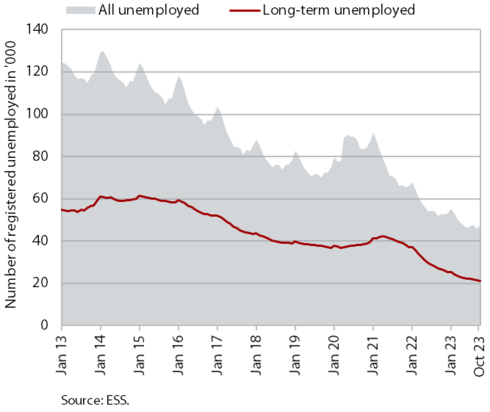Charts of the Week
Charts of the week from 6 to 10 November 2023: number of registered unemployed persons, electricity consumption and production volume in manufacturing
The number of registered unemployed continued to fall in October, albeit at a much slower rate than at the beginning of the year. Year-on-year, their number fell by 10.9%. Given the labour shortage, long-term unemployment is also down significantly. Manufacturing output continued to shrink in the third quarter, with the year-on-year decline still being the sharpest in most energy-intensive industries. The year-on-year decline in electricity consumption in October was significantly lower than in previous months, which could be partly due to last year’s relatively low base.
Number of registered unemployed persons, October 2023

According to the seasonally adjusted data, the monthly decline in the number of registered unemployed in October (0.6%) was similar to previous months, but much lower than at the beginning of the year. According to original data, 47,232 people were unemployed at the end of October, 2.7% more than at the end of September. This largely reflects seasonal trends related to a higher inflow of first-time job seekers into unemployment. Unemployment was down 10.9% year-on-year. Amid labour shortages, the number of long-term unemployed (more than 1 year) fell by one fifth year-on-year at the end of October.
Electricity consumption, October 2023

Electricity consumption was 5% lower year-on-year in October. The year-on-year decline was significantly lower than in previous months, which could also be due to last year’s relatively low base as a result of the slowdown in economic activity and high electricity prices. Among Slovenia’s main trading partners, lower consumption compared to October 2022 was recorded by Austria (-5%), while consumption in other trading partners was higher year-on-year, in France by 1%, in Croatia and Germany by 2% and in Italy by 4%.
Production volume in manufacturing, September 2023

Manufacturing output continued to shrink in the third quarter. The decline compared to the previous quarter deepened despite the growth in production volume in September. Production continued to shrink in medium- and low-technology industries and, for the first time this year, in high-technology industries (which are characterised by significant monthly fluctuations in production). Compared to the same period last year, production in the third quarter was also down in all industry groups according to technology intensity (by an average of 8.0%). The decline continued to be strongest in the majority of energy-intensive industries (manufacture of chemical products, paper and basic metals). Only in the manufacture of food products, manufacture of machinery and equipment n.e.c. and repair and installation of machinery and equipment was the production higher year-on-year. In these industries, and in high-technology industries and the manufacture of leather, production in the first nine months was higher year-on-year. On average, production in manufacturing in the first nine months was 3.8% lower year-on-year.
